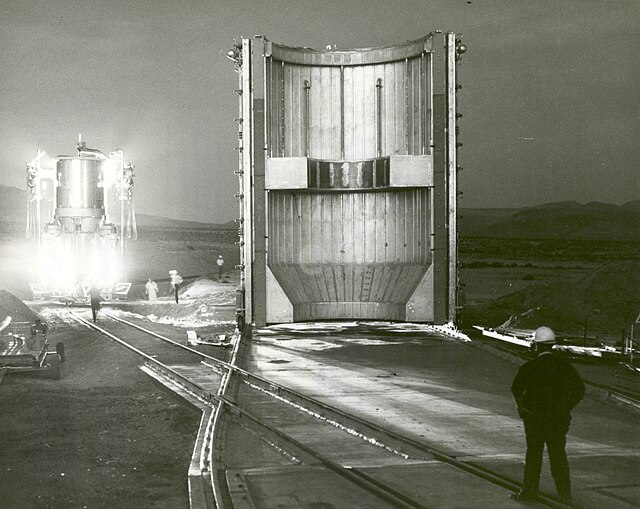The Nuclear Engine for Rocket Vehicle Application was a nuclear thermal rocket engine development program that ran for roughly two decades. Its principal objective was to "establish a technology base for nuclear rocket engine systems to be utilized in the design and development of propulsion systems for space mission application". It was a joint effort of the Atomic Energy Commission (AEC) and the National Aeronautics and Space Administration (NASA), and was managed by the Space Nuclear Propulsion Office (SNPO) until the program ended in January 1973. SNPO was led by NASA's Harold Finger and AEC's Milton Klein.
NERVA XE in ETS-1
Engine maintenance assembly and disassembly (E-MAD) facility
President John F. Kennedy (right) visits the Nuclear Rocket Development Station on 8 December 1962 with Harold Finger (left) and Glenn Seaborg (behind)
The High Energy Rocket Engine Research Facility (B-1) (left) and Nuclear Rocket Dynamics and Control Facility (B-3) (right) at NASA's Plum Brook Station in Sandusky, Ohio, were constructed in the early 1960s to test full-scale liquid hydrogen fuel systems in simulated altitude conditions.
A nuclear thermal rocket (NTR) is a type of thermal rocket where the heat from a nuclear reaction replaces the chemical energy of the propellants in a chemical rocket. In an NTR, a working fluid, usually liquid hydrogen, is heated to a high temperature in a nuclear reactor and then expands through a rocket nozzle to create thrust. The external nuclear heat source theoretically allows a higher effective exhaust velocity and is expected to double or triple payload capacity compared to chemical propellants that store energy internally.
1 December 1967: The first ground experimental nuclear rocket engine (XE) assembly is shown here in "cold flow" configuration, as it makes a late evening arrival at Engine Test Stand No. 1 in Jackass Flats, Nevada. The engine is in the left background with a shield structure in the mid/foreground.
A NERVA solid-core design
Pulsed nuclear thermal rocket unit cell concept for Isp amplification. In this cell, hydrogen-propellant is heated by the continuous intense neutron pulses in the propellant channels. At the same time, the unwanted energy from the fission fragments is removed by a solitary cooling channel with lithium or other liquid metal.
The KIWI A prime nuclear thermal rocket engine








